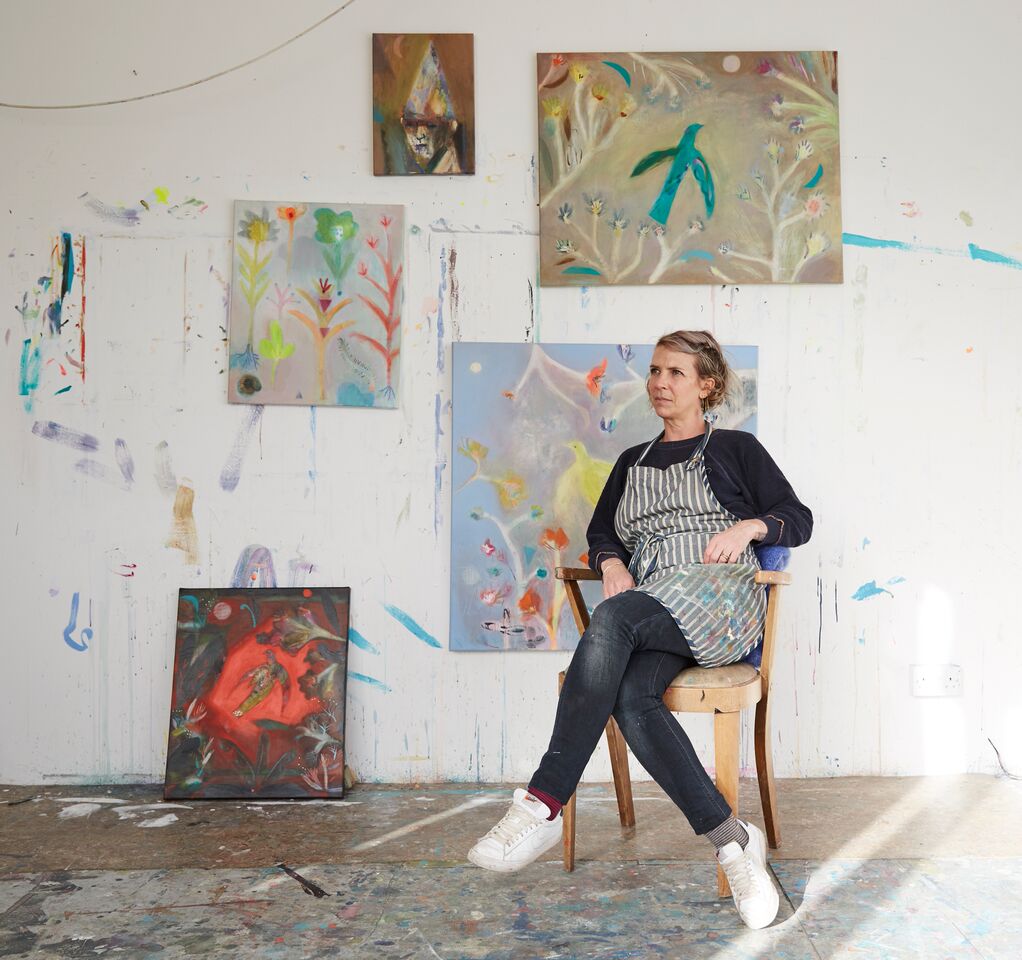
Becky Blair with her art.
This is a guest post by Adrianna Kamosa
Lupus and other chronic illnesses can often be painful and exhausting, but these five visual artists have found ways to combat the pain through creative endeavors. Some translate their pain into their artwork, while others draw inspiration from other elements of their life. Each artist has pursued their passion for creativity, despite fighting unique battles with chronic illnesses.
If you are a chronic illness warrior who loves anything creative, you’ll want to learn more about these five artists:
Willow Bascom
In her childhood, Willow Bascom grew up in Saudi Arabia and Panama. She also traveled throughout many countries within Europe, Africa, Latin America and the Far East. Little did she know that these travels would influence the designs and colors within her art. She describes art as a universal visual conversation. She terms art that involves many different cultural styles and traditional styles, World Art.
After a draining 12 years with Lupus, she began to draw. Her art can be described as having a heavy African and cross-cultural flare. Her brightly colored designs of animals are filled in with overlapping and connecting patterns or symbols. Since having Lupus, Bascom has found ways to continue pursuing her art. According to her interview with The Vermont Journal, She was unable to use colored pencils because of the grip, so she evolved to using larger colorful sharpies. She draws the outline for each drawing by hand, scans the drawing, and then uses Adobe Photoshop to fill in color.

The cover of the children’s book “Paisley Pig and Friends, A Multicultural ABC” by Willow Bascom
Willow’s beloved children’s book “Paisley Pig and Friends” brings together geography, art, and culture in an alphabet book. Each animal is introduced using a different artistic style, as well as maps and lessons on where each artistic style originated. Through each patterned animal, she speaks of the way an artistic style may originate in one part of the world, but then be adapted to many other parts of the globe. Willow Bascom’s art has bridged different cultural artistic designs and will continue to do so in the generations to come.
Elizabeth Jameson
In 1976 Elizabeth Jameson was a Bachelors graduate of Stanford University and a new practicing Doctor of Law from University of California, Berkley. During that time, and the years following, her health took a turn. Elizabeth progressively developed symptoms of nerve damage from Multiple Sclerosis.
Her aim throughout her college years was to practice Law, to better social justice and poverty. During her doctoral studies, she married a man whom she loved and had two beautiful boys. But her life coinciding with illness crashed into her like a “tsunami” as she calls it. After many weeks in the hospital, tests, and MRI’s, she saw the signs that this illness would not go away. Her purpose servicing in Law slipped through her fingers.

Elizabeth Jameson speaking at a Stanford Medicine event about breaking the silence in the waiting room.
It took one art class from a caring friend to give her another purpose in life. After a few existential crises, she began to look at her stark black and white MRI scans in a new light and began to add bright etchings of color. In her TED Talk, she discusses how her art has brought those in the ALS community, brain tumor community, and other chronic illness communities, together. Best of all she has found a sense of happiness and joy in her art.
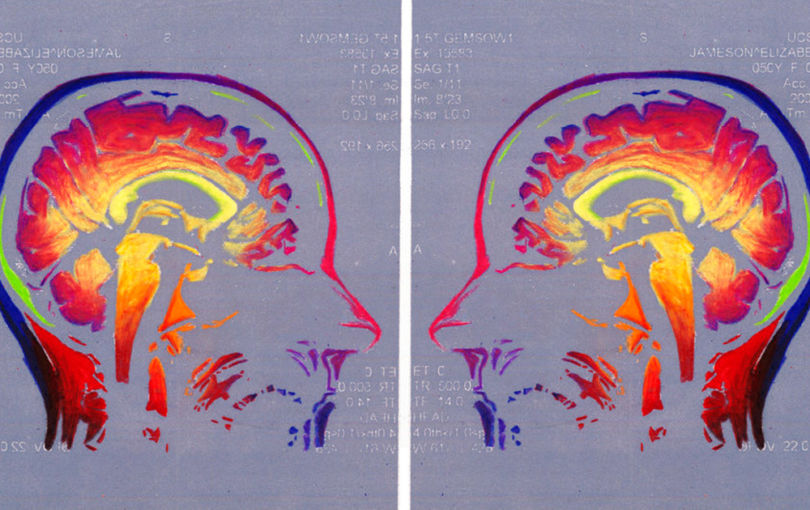
Conversations With Myself: Brain Diaries II by Elizabeth Jameson
Elizabeth’s images make the viewer take a deeper look into their mind and body. Many of her etchings translate the scans of a depressing debilitating illness into happy spectrums of rainbow colors, happy birds, and jovial dancers. Her art has been installed in many educational and medical institutions, imprinted on book covers and displayed within articles. Elizabeth Jameson’s Multiple Sclerosis has brought her much pain and has deemed her unable to use her arms or legs, but it has opened her up a whole new world of art and a community to stand behind it.
Rita O’Hara
One morning in the year of 1978, Rita O’Hara knew something was wrong with her 30-year-old body. Pain shot from joint to joint and she was unable to get out of bed. According to an article from Everyday Health, the landscape and portrait artist eased some of her pain and undiagnosed symptoms with medications until 1982, when she lost the use of her left shoulder joint. At that point, O’Hara was diagnosed with Rheumatoid Arthritis.
Despite medications and altering her diet to be mostly vegetable based, O’Hara has had to have several joint surgeries including, two hip replacements, surgery to the knuckles in her hands and toes, and an elbow surgery. Rheumatoid Arthritis causes painful swelling and deformity in joints, which can be improved with surgical intervention. She also has been taking the medication Enbrel or etanercept, relying on these injections twice a week to help her lead a more normal life.
Rita says her art has helped her heal. To her, art can be meditative and “life-giving” with such a life-taking illness, such as RA. Rita is fairly flexible in her right wrist and hand, which is the hand that she paints with because she uses it so often. Unlike osteoarthritis, which is caused by continuous use and wear on joints, rheumatoid arthritis is an autoimmune disease and staying active can sometimes help the joint pain.
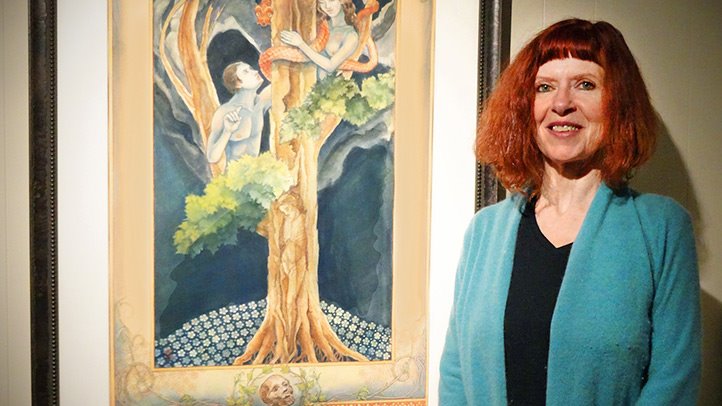
Rita O’Hara with her art. She stands next to her art piece titled, “We lose because we win.”
Rita paints with gouache, rather than oil paints, to ease any burden on her body and to lessen her exposure to harmful chemicals. Rita’s art consists mostly of figures in differing landscape environments, climbing trees, grouped together or painted alongside skeletons. Many paintings offer a symbolism in reference to life, death, humanity, or religion. Each of her paintings is titled using lines from Emily Dickinson’s poetry. Her work portrays a medieval style; each painting captures a story up to the onlooker’s interpretation. In an article with Everyday Health, Rita recommended art or other creative outlets to those with RA or other chronic illnesses, stating: “I think when you are involved with RA, you are involved with loss and maybe sometimes despair, but art is a good balance for that.”
Anna Cowley Ford
Anna is a ceramics and mixed media artist living with chronic migraines and chronic pain. Her illnesses and pain greatly inspire her work. She utilizes art as a way to show how her pain feels. She always has a headache, but the pain varies from day to day. Ever since she was a little girl the migraines were a constant in her life, she was unable to focus properly in classes, especially for extended periods of time.
She still continued to go to college to study art, but this came as a challenge when her family support network wasn’t there. According to the YouTube video “Dilemma: A Decade of Chronic Pain,” she has oftentimes found friendship and relationships challenging in the fact that she cannot always happily do the same things other people could do without chronic illness. In those times she often had doubts about her chronic migraines and pains, she questioned herself and the pain she had. But after speaking with a professor who also had chronic migraines, she stated: “Having the conversation with her was this eye-opening moment of, I’m not making this up, I’m not crazy, and this pain is real and valid.”
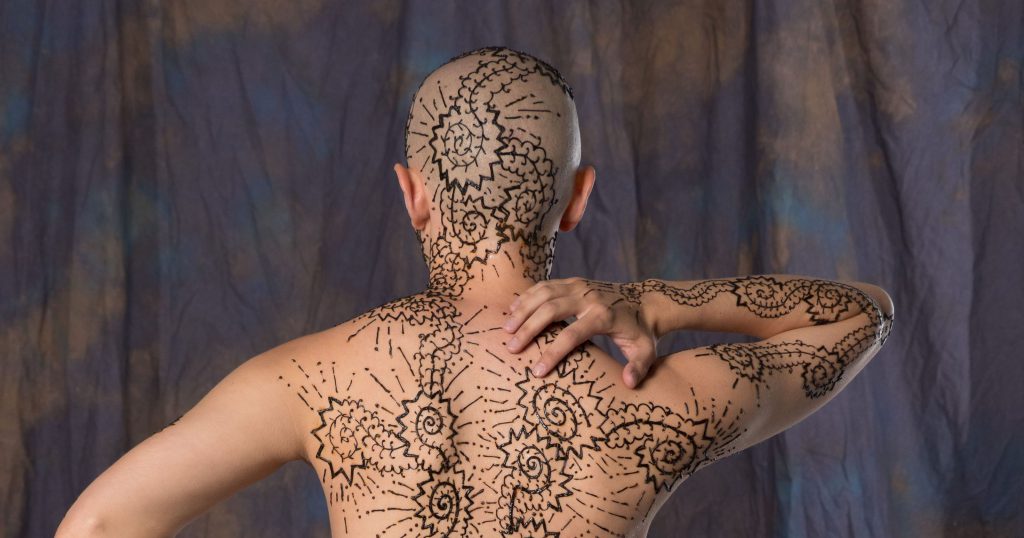
Anna Cowley Ford with her Henna designs drawn on her body showing how her pain spreads throughout her body.
Anna was officially diagnosed with Ehlers-Danlos Syndrome and Endometriosis, which also helped justify her pain, fatigue, and headaches. After understanding that other people have similar symptoms, she began to translate how her pain felt through her art. Anna began creating clay busts of her head, cracking and prodding them to resemble what her chronic migraine pain felt like. She also used henna to draw on her skin where the pain occurred, putting into perspective how much of her body felt in pain. Anna works with a Henna artist, Amanda Horner, and photographer, Steve Butman to achieve her striking images. She repeats these two projects every five years to document the evolution of her pain. Anna hopes that her artwork will bring awareness of chronic pain to the world, and help others know they are not alone.
Becky Blair
Becky Blair is an artist from Brighton, England. Like many cases of Lupus, one morning she woke up feeling extremely tired, so tired that she was barely able to get out of bed. According to an interview with Brighton Journal, she saw many doctors and for a long time did not get a clear diagnosis. Finally, a doctor sent her to the hospital and her final blood tests came back. After months of losing weight, near paralysis and much pain, she was diagnosed with Lupus. Blair began to take medication that eased her symptoms. After a few months, she was inspired to paint more than ever before.

Becky Blair with her art.
Blair comes from a creative family; her siblings, as well as her stepfather and blood father, are creative individuals. She had done art exhibitions of her work before getting sick, but had felt in a rut. Since she never painted when she was very ill, she took the opportunity of her improved symptoms to change her artwork and style.
Her current style can be described as whimsical, layered and bright. She uses many overlapping shapes, mostly triangles, and brightly colored acrylic paints. In an interview with Brighton Journal she describes the process of her art as: “I draw from my life experience(s), and I take the symbols that I’ve developed – like the birds, the triangles, and the trees, and I work them out a bit in sketchbooks, playfully exploring through doodling, letting ideas flow.” She then translates those sketches onto a canvas. She describes her process as an organic “conversation” between her and the canvas. She lets the colors and shapes come naturally to her in their own private “language.”
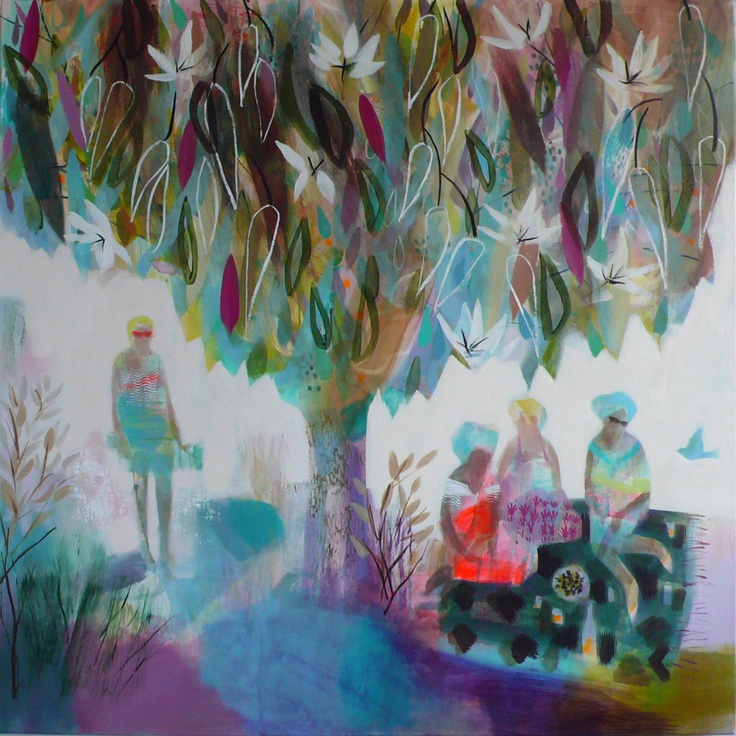
“Lazy Afternoon” By Becky Blair
Many of her painting feature figures, shapes trees and birds. Each painting draws inspiration from her life, sickness, or travels. Lupus had at times left her unable to be as functional as most people, but she has progressively improved her health through medications, lifestyle, and her art. Her brightly colored paintings show her optimism in the face of the challenges illness presents. Her work is sold through exhibitions and private commissions internationally, like many artists who have found their passion in life through art.
Are you an artist and a part of the LupusChick community? We would love to feature your work and your story on the blog. Send us some pictures of your art and a little bit about yourself. How has having Lupus or another chronic illness defined your art or evolved it? Did you start painting, drawing, or sculpting before or after you were diagnosed with Lupus? We’d love to hear from you! Send us an email at marisazeppieri@gmail.com and akamosa70@gmail.com.
 Adrianna is a writer, artist, and marketer currently living in Virginia Beach. She enjoys spending quality time with family, with her pets, and in nature.
Adrianna is a writer, artist, and marketer currently living in Virginia Beach. She enjoys spending quality time with family, with her pets, and in nature.


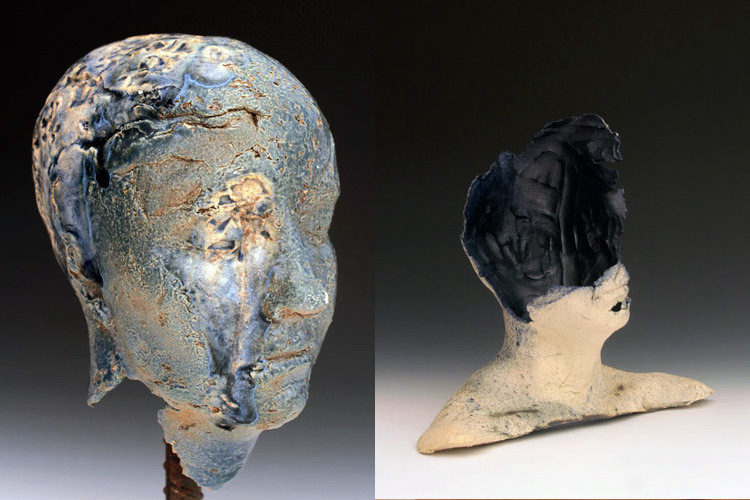
I’m actually new in this page and I have been following on YouTube but I can’t find new videos. I’m newly diagnosed with systemic lupus and I see that you have way more experience in the area. I was a social worker and a makeup artist that will Teo support groups for women with harsh treatments for condiciona like cancer or lupus and were having a hard time with grieving themselves. I will give away makeup and talk about self esteem. Well, I AM the SICK one now and I need help. I have a lot of complications but I want to serve in my chronically ill community somehow. I was wondering if I can contribute with articula for self care, self esteem, what can we do to feel a little better and look better for ourselves. I was even thinking is I can contact companies that can donates us makeup and do like group under your website I don’t know just and idea. My
Proyect stared in 2009 in Miami and LA but now I live in Minnesota. Let me know what you think.